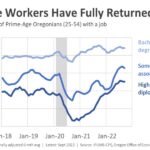More than half of employers on the Mac’s List survey reported trouble finding candidates, while 80% were hiring.
A new report from the Pacific Northwest job board website Mac’s List shows that when it comes to employers and job seekers, people looking for work are in the driver’s seat — and likely will be for the foreseeable future.
A survey of 115 local employers in Oregon and Washington found 80% of employers planning to hire in the next 12 months. More than half of those companies also reported having trouble filling their open positions, with 56% of respondents saying they were having difficulties finding the right candidates, and 55% responding they were having difficulties reaching a more diverse base of job candidates. Nearly half — 47% — said offering competitive wages and benefits is a challenge, and 28% said the labor shortage is a problem.
“This really does remain a jobseeker’s market, which is a huge sea change,” Mac’s List founder and CEO Mac Prichard tells Oregon Business. “There were a couple of periods in the ‘90s where jobseekers were in the driver’s seat, but we haven’t seen this kind of dynamic nearly since then, and since the 1970s. Employers struggle with this because they are accustomed to putting out job postings and getting lots and lots of applications, and they’re telling us they’re not seeing the volumes of applications they got in the past.”
He says the results show diversity, equity and inclusion initiatives are something companies are continuing to invest in. “Diversity, equity inclusion is a priority for employers. It’s something that they identified that matters to them, and that they’re making a priority in their hiring.”
Most of the companies surveyed for the Mac’s List report were recruiting for jobs in the nonprofit, education, public sector, professional services and health care sectors. But the results are in line with broader trends.
Unemployment is at low levels across the country, with many states, including Oregon, at or below historic lows. Oregon unemployment was at 3.4% in August of 2023, tied with its previous record in April 2020. Current national unemployment stands at 3.8%, with layoffs also at historically low levels.
The survey found employers are increasingly likely to list a salary, or salary range, in job postings, with 90% of survey respondents saying they do so[CM1] . The report also notes that nationally, salary transparency in job postings more than doubled between 2020 and 2023, with 43.7% of job postings offering salary information in 2023 versus 18.4% three years ago. (Employers in Washington state are now required to post salary data, the report notes.)
The survey found 14% of employers were looking to fill a remote position in the next year, and 36% will fill a hybrid position. This tracks with national estimates. A June report by Forbes found 12.7% of full-time employees in the U.S. work from home, with 28.2% working a hybrid model.
The good news for employers, per the report, is that the Great Resignation seems to have receded, with 51% of employers reporting that retention rates are about the same and 23% indicating higher retention than usual.
“As employers have gotten smarter about hiring, they’ve attracted people who especially want to be there. I think because it’s been a job seekers market for the last few years, it’s given workers an opportunity to not only look around for better opportunities but to make the most of those opportunities and get clear about exactly what they want,” Prichard says.





